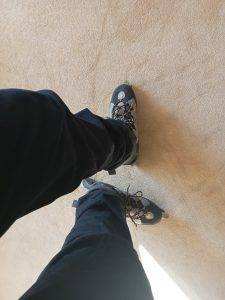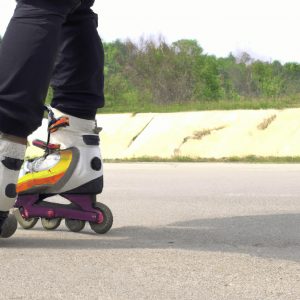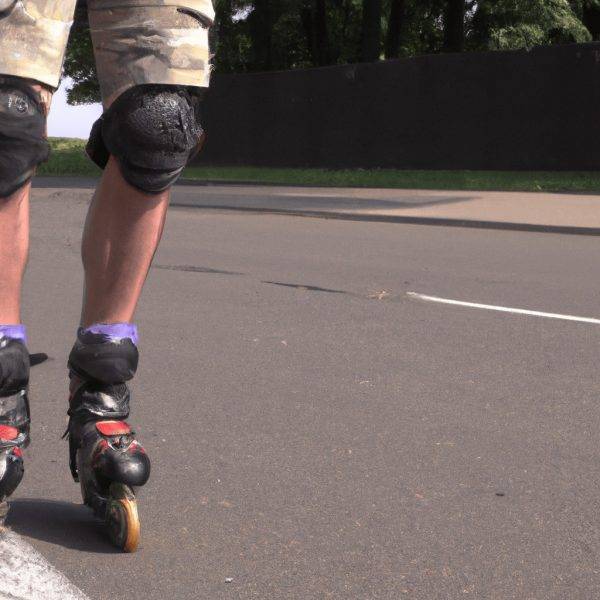Table of Contents
An Overview of Ways to Stop on Inline Skates Without Brakes
In this post, we’ll take a look at the different ways to stop without brakes and what to consider when deciding which technique is right for you.
NEMONE Mermaid 4 Size Adjustable Light up Roller Skates for Girls, Purple Blue Skates for Toddlers, Beginner Kids Roller Skates Indoor Outdoor
$59.99 (as of 06/29/2024 12:03 GMT +01:00 - More infoProduct prices and availability are accurate as of the date/time indicated and are subject to change. Any price and availability information displayed on [relevant Amazon Site(s), as applicable] at the time of purchase will apply to the purchase of this product.)The T-Stop Technique
The T-Stop is a technique used by inline skaters to come to a complete stop without the need for brakes. It involves placing one skate in a T-shape on the ground and applying pressure into the ground.

The T-Stop is an effective way to stop quickly, but it requires a fair bit of practice and skill to do it correctly.
To begin, the skater should start by positioning the skates in a T-shape on the ground with one foot facing forward and the other at 90 degrees to the other. Apply pressure into the ground with the foot that is at 90 degrees. This will cause the skater to slow down gradually as they glide across the surface.
Apply more pressure until you come to a stop completely. It is important to remember to keep the knees bent and the back straight when doing this, as this will help you stay in control and avoid any potential accidents.
The T-Stop is a great way to stop quickly without the need for brakes and can be used in a variety of situations.
It is especially useful for beginners who are just getting used to inline skating and need to learn how to stop quickly.
With enough practice, anyone can master this technique and be able to stop safely and confidently on their skates.
Triple Eight Saver Series Pad Set with Kneesavers, Elbowsavers and Wristsavers
$39.99 (as of 06/29/2024 12:03 GMT +01:00 - More infoProduct prices and availability are accurate as of the date/time indicated and are subject to change. Any price and availability information displayed on [relevant Amazon Site(s), as applicable] at the time of purchase will apply to the purchase of this product.)The V-Stop or Plow-Stop Technique
The V-Stop or PlowStop technique is one of the most efficient ways to stop on inline skates without the use of brakes.
It is a technique that involves using the edges of the wheels to slow down the skater and eventually come to a complete stop. While it is a relatively simple concept, mastering the technique can take some practice and skill.
The V-Stop or PlowStop technique is based on the idea of using the edges of the wheels and turning the toes of both skates inwards to create a “V” shape to slow down and eventually stop the skater.
The technique involves leaning forward and pressing the inside edge of the wheels against the ground. This will cause the skater to slow down, and eventually come to a complete stop.
The V-Stop or PlowStop technique is a great way to stop quickly and safely on inline skates. It is especially useful in tight spaces or on uneven surfaces, as it requires less physical effort than other stopping techniques.
In addition, it requires no special equipment, making it an accessible way to slow down and stop.
The Turn and Stop Technique

The Turn and Stop Technique is a great way to stop on inline skates without brakes. This technique involves turning the skates in the opposite direction.
The first step in the Turn and Stop Technique is to twist your shoulders around in the opposite direction.
This is followed down your body and into the skates so that eventually you are facing the opposite direction.
The Turn and Stop Technique is a great way to stop on inline skates without brakes.
It is important to practice the technique and make sure you are comfortable with the movements before attempting to use it in a skating session.
OutdoorMaster Skateboard Cycling Helmet-Beetles Snug,Bike Helmet for Adults, Youth & Kids-Two Removable Liners Ventilation Multi-Sport Commuter Scooter Roller Skate Inline Skating Longboard
$19.99 (as of 06/29/2024 12:03 GMT +01:00 - More infoProduct prices and availability are accurate as of the date/time indicated and are subject to change. Any price and availability information displayed on [relevant Amazon Site(s), as applicable] at the time of purchase will apply to the purchase of this product.)The Hockey Stop or Power Slide Technique
This type of stop is one I used to use all the time when ice skating, doing this stop when ice skating creates a spray of ice (which was normally directed at one at a friend or a girl I was trying to impress, boys will be boys and no wonder I often went home on my own 😊).
The Hockey stop is not one that I would recommend on inline skates but for the sake of continuity, this is how to perform the hockey stop/power slide.
Whilst skating in a straight line turn your trailing foot in the opposite direction, turn the leading foot 90 degrees to the trailing foot and apply pressure into the ground whilst tilting the skate.
You will need to keep yourself low and tilt the skate as much as possible, the advantage of this stop is that it will bring you to a rather rapid stop.
The Staggered Stop Technique
The Staggered Stop Technique is one of the most common ways of coming to a stop while skating without brakes. It is a simple, yet effective technique that can be used by both beginner and advanced skaters alike.
In this technique, the skater uses the momentum of their body and their skates to come to a gradual stop in a controlled manner.
To perform the Staggered Stop Technique, you will need to first gain some momentum and then begin to slow down by turning your skates inwards and to the side.
You should do this in a staggered pattern, alternating your feet to ensure that you have enough control over your speed and direction. As you turn your skates inwards, the edges of the wheels will come into contact with the ground, slowing you down gradually.
Once you have slowed down enough, you can then come to a complete stop by bringing your skates back underneath you and into a “V” formation. This will help you to keep your balance and stop in a controlled manner.
BOSONER Kids/Youth Knee Pads Elbow Pads Wrist Guards Set for 3-15 Years, Child Protective Gear Set for Roller Skates, Cycling, BMX Bike, Skateboard, Inline Skating, Scooter Riding Sports…
$19.99 (as of 06/29/2024 12:03 GMT +01:00 - More infoProduct prices and availability are accurate as of the date/time indicated and are subject to change. Any price and availability information displayed on [relevant Amazon Site(s), as applicable] at the time of purchase will apply to the purchase of this product.)Conclusion
Learning how to stop on inline skates for beginners without brakes can be a bit of a challenge, but with practice and patience, it can be done. Just remember to wear safety gear whilst carrying out these new techniques, start slowly and build up.
With practice, these techniques can be mastered and used to stop on inline skates without brakes. Once you become comfortable with your stopping technique, you’ll have more confidence and be able to enjoy the sport of inline skating even more.





